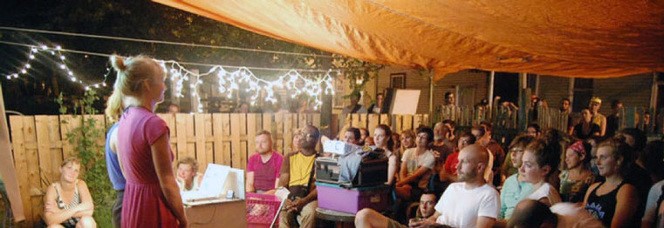
Freie Plätze im Blockseminar: „Form + Content: Work-shopping the Lecture Performance“ mit Ella Tetrault. Geöffnet für Master!
29./ 30. April und 06./07. Mai
Klips1 Klips2
Bei Interesse baldige Rückmeldung an aurora.rodono@uni-koeln.de
Eine Anmeldung in Klips ist nachträglich während der 3. Belegungsphase (09. Mai bis 16. Mai 2016) möglich.
The Lecture Performance acts as an amalgam of the traditional lecture format, pedagogical practices, academic research, performance techniques and visual art. It is a means of shifting predominant art discourses and forming a new exchange of art dialogue perpetuated by artists. With a movement toward dialogue and alternative pedagogies with Grant Kester’s Dialogical Aesthetics, the Bruce High Quality Foundation, MOMA’s recent Art Speech, a Symposium on Symposia and Hennessy Youngman’s youtube lectures Art Thoughtz, there is an increasing desire to use the hybrid lecture format not as a supplementary tool to one’s art practice, existing only on the periphery, but as a central part of it. We will review the beginning of the Lecture Performance as a sub-genre of 1960’s performance art with lectures such as Robert Morris’s 1963 21:3 and Joseph Beuys’ 1965, “How to explain pictures to a dead hare” and move into the role of the Lecture Performance in institutional critique with lectures such as Andrea Fraser’s 1989, Museum Highlights. Through this framework, we will investigate the gaining momentum of this genre in contemporary art. How do we as artists perceive and make use of this intersection in our own work and research? The intention is to create a framework and conduct a series of practice-based experiments that explore the performance lecture and it’s relationship to pedagogy, knowledge and visual art.
Biography:
Ella Tetrault is a Canadian artist residing in Berlin. She holds an MFA in Public Art and New Artistic Strategies from the Bauhaus University and a BA in International Development from the University of Toronto. As a former youth worker and international development student, she often makes use of qualitative research and narrative therapy methods. Her projects tend to take place over a long period of time and evolve as new relationships are forged and new information is acquired. She uses lectures, film and installation to explore the idea in narrative therapy that individuals are continuously reinventing their own history through re-telling their story. Throughout, there lies a desire to connect with others through curated environments and experimental methods of asking questions. She shares a collaborative practice with Bethany Riordan Butterworth- together, they curate the Fuller

